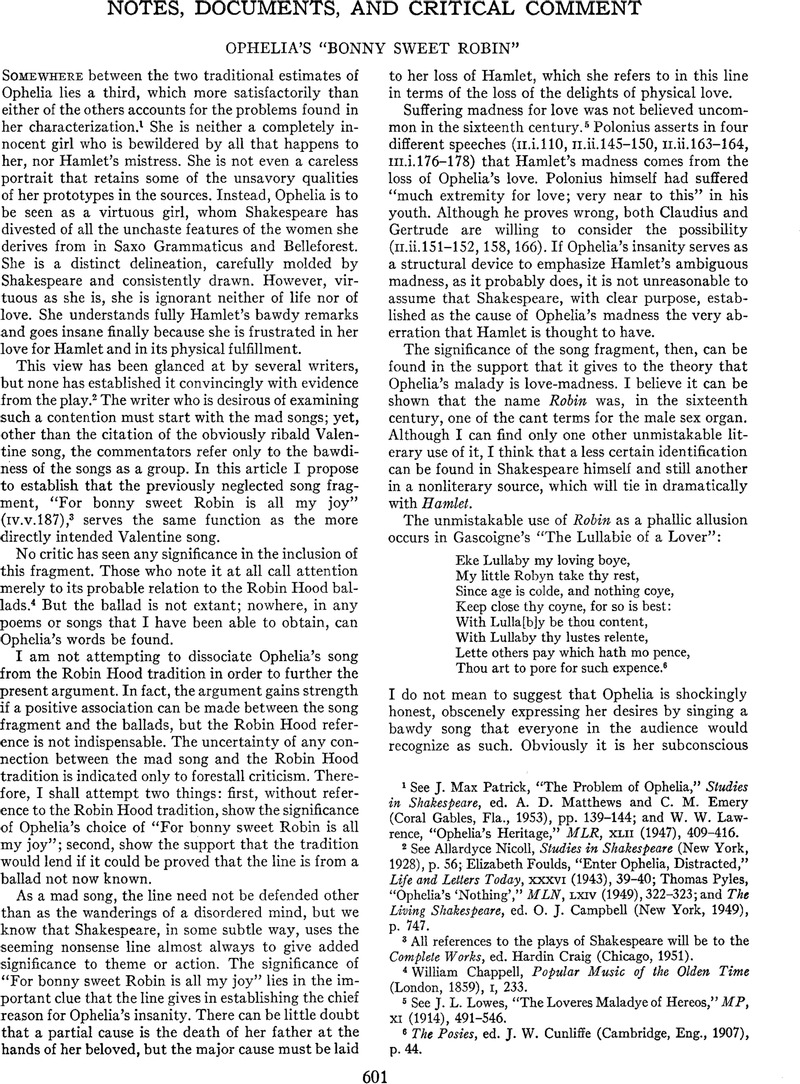Article contents
Ophelia'S “Bonny Sweet Robin”
Published online by Cambridge University Press: 02 December 2020
Abstract

- Type
- Notes, Documents, and Critical Comment
- Information
- Copyright
- Copyright © Modern Language Association of America, 1958
References
Note 7 in page 602 See Pyles, pp. 322-323. A further illustration of Ophelia's poise not noted by Pyles occurs when Hamlet rants against the players who have perhaps spoiled his dumb-show trap: Ophelia. Will he tell us what this show meant? Hamlet. Ay, or any show that you'll show him : be not you ashamed to show, he'll not shame to tell you what it means. Ophelia indicates her complete understanding by chiding, “you are naught, you are naught: I'll mark the play” (in.ii.153-158). It is not entirely impossible that Ophelia here retorts consciously with a bawdy reply of her own.
Note 8 in page 602 See especially Esther Singleton, The Shakespeare Garden (New York, 1931), p. 209. Other writers concurring are Sidney Beisly, Leo. H. Grindon, Henry N. Ellacombe, and James H. Bloom.
Note 9 in page 602 Rembert Dodoens, A Niewe Herball; or, Historié of Plantes, trans. Henry Lyte (London, 1578). For assistance in checking herbals not available to me I should like to record my gratitude to Dr. Joseph Ewan of the Tulane Botany department, Dr. George B. Van Schaack of the Missouri Botanical Garden, and Dr. William Wiatt of Indiana University.
Note 10 in page 602 “They haue eaten so much wake-Robin, that they cannot sleepe for loue” (i.ii.18-19) (Complete Works of John Lyly, ed. R. W. Bond, Oxford, 1902), iii, 303.
Note 11 in page 602 Its appearance in Rabelais is cited in Slang and Its Analogues: Past and Present, ed. J. S. Farmer and W. E. Henley (London, 1890-1904), v, 293.
Note 12 in page 602 A Dictionairie of the French and English Tongues, ed. W. S. Woods (Columbia, S. C, 1950).
Note 13 in page 603 George Peele, King Edward the First, ed. W. W. Greg (Oxford, 1911), 11. 1299-1305. E. K. Chambers cites additional evidence, The Mediaeval Stage (Oxford, 1903), i, 174, 181.
Note 14 in page 603 It is possible that Chaucer's Troilus and Criseyde makes reference to Robin Hood and shows a corrupt tradition antecedent to the play cited above: “From haselwode, there joly Robyn pleyde, / Shal come al that that thou abidest heere” (w.1174-75) (Complete Works of Geoffrey Chaucer, ed. F. N. Robinson, Boston, 1933). Pandarus is comforting Troilus; the meeting that Troilus awaits is with Criseyde.
Joseph Ritson supplies other early nonliterary references in Robin Hood (London, 1887), I, lxxiii; I, c.
Of considerable interest and importance in the vulgar connotations of Robin are some of the attributes and grosser pranks of Robin Goodfellow. See The Mad Pranks and Merry Jests of Robin Goodfellow, ed. J. Payne Collier, Percy Society (London, 1841), n, 27,33-35; Greenes Newes both from Heauen and Hell, ed. R. B. McKerrow (Stratford, 1922), p. 61; and the obscene woodcut cover to The Mad Pranks reproduced in John Ramsbottom, Mushrooms Toadstools (London, 1953), p. 135.
Note 15 in page 603 Collections I, Part II, ed. W. W. Greg, Malone Society (Oxford, 1908), p. 132.
Note 16 in page 603 The Plays and Poems of Robert Greene, ed. John Churton Collins (Oxford, 1905), n, 207,11. 848-851; English Madrigal Verse: 1588-1632, ed. E. H. Fellowes (Oxford, 1920), p. 536, 11. 25-26.
- 4
- Cited by




